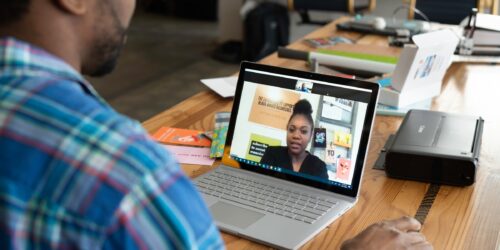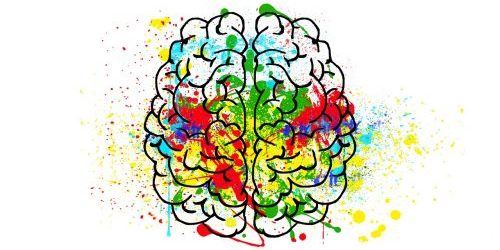
Student Self-Directedness in Online Learning
This teaching tip describes what is self-directedness for synchronous and asynchronous online learning, considers caveats when thinking about perceived levels student self-directedness, and shares ideas for supporting fully online learners to thrive in online courses.
Roles in and Readiness in Online Courses
As faculty, your role is to guide and support student learning towards course learning outcomes through teaching duties that include sharing information, reminders, explanations, examples, expertise, guidance, clarification, and feedback. Students may need explicit guidance and support in the asynchronous course mode to achieve learning outcomes. How ready are your students to:
- access and navigate the course with ease?
- sit at a computer on their own without distraction?
- manage their own study time without a structured class?
- use the course tools with ease?
- follow their interests with self-guided research?
- seek answers to their questions on their own?
- understand rubrics and assignment instructions without in-person explanations?
- complete self-check activities with no grades-based incentives?
- manage remote group work?
- balance course work along personal and professional responsibilities?
Self-Directedness and Learning
Self-directed learning is a good candidate for what the great cognitive psychologist Vygotsky called a ‘higher mental function’ or a ‘tool of thought’ (in 1978, p. 126), a mental “organ” developed over time through a particular history of social interaction, which can operate in any situation.“
(Grow, 1991, p. 5)

Self-directedness is managing one’s self and adapting to the demands of a situation. Learners are self-directed when they take the initiative to understand their own learning needs, formulate goals, find learning resources, manage their time, and apply strategies and feedback they receive to support their learning (Grow, 1996, in Stavredes, 2013).
Self-directed learning involves taking responsibility for one’s own learning, embrace autonomy, and making decisions based on preferences (Tekkol & Demirel, 2018). There are many competencies that support self-directed learning–formed by a combination of personality and contexts–which can include:
- Setting clear learning goals
- Shaping learning process in line with goals and plans
- Monitoring learning process es
- Evaluating outcomes of their own learning
- Being self-motivated
- Being open to learning
- Being willing to learn
- Valuing learning
- Using self-control
- Taking the initiative
- Seeking answers to questions using course materials
There are a number of dimensions that affect self-directedness, including the personality, learning processes, and situational factors (which included how knowledge is construed in the classroom) (Morris, 2019).
Self-Directed Learning in Research Literature

In 1991, Gerald Grow proposed a Staged Self-Directed Learning (SSDL) Model, in which he charted patterns of learner traits and teaching habits to support four different levels of self-directedness (e.g., Dependent Learner, Interested Learner, Involved Learner, Self-Directed Learner). Grow aimed to assist faculty with adapting their teaching style to match students’ learning needs as well as building students’ self-directedness.
Shortly after, Mark Tennant (1992) critiqued Grow’s SSDL model and its claims. (Some of the ideas are noted below). Since the 1990s, self-directedness in learning has flourished as a subject of research, theory, and practice in the fields of adult learning (Merriam et al., 2007) and, more recently, online learning and technology readiness (Geng et al., 2019).
Learn about the SSDL model and the 4 stages in this research-informed video:
Tekkol and Demirel (2018) note that in more recent research literature self-directed learning is often linked with higher order learning skills like critical thinking, problem-solving, and creativity. Linkous (2020) observed that descriptions of student self-directedness as influencing the external learning environment, while student self-regulation relates to internal forethinking, monitoring, and reacting within learning situations. Teachers who promote self-directed learning are often grounded in a constructivist pedagogy, as they see learners as active participants in their learning (Morris, 2019).
Supporting Less and More Self-Directed Students
Besides, this article is not about self-directed learning theory; it is about teaching.“
(Grow, 1991, p. 5)
Below are ideas about identifying student needs, supporting less and more self-directed learners, and adjusting to changing needs.
Assess the Level of Student Self-Directedness
Your course and lessons within it may designed to be linear, highly structured, instruction-centred, and step-by-step. It may include conditional released content, which reduces choice in how to proceed through the course and assignments. This design approach runs counter to the adult learning theory that suggests students should be active and interactive in the learning process (Kasworm & Yao, 1992). If students are unable to make some or exercise their autonomy in some ways, the course may limit interactive meaning construction and the development of learning-how-to-learn skills.
Or, your course and the lessons within it may be designed provide learning opportunities that require high levels of agency, choice, and autonomy, such as those involving discussion, game-based learning, problem-solving, independent research, group work, choice in assignment types, etc. (Taub et al., 2020). While at least some agency and choice benefits most learners (Jang, 2016; Taub et al., 2020), if students are required to be highly interactive and independent–or interdependent with peers)–some students may become anxious, overwhelmed, or confused.
Grow (1991) described “clues” to determine the general level of self-directedness that your students may present in class. Note that Tennant (1992) critiques easy categories of self-directedness, so consider with caution.
- Doing the maximum on activities, or the minimum?
- Inventing ways to continue through a problem, or stopped by the first obstacle?
- Exploring a topic on their own, or benefit from a series of steps to follow?
- Voluntary or prompted participation in class discussion?
- Reading the assignment to critique or to remember/understand it?
- General directions for activities needed, or requests for everything to be spelled out exactly?
- Pressure of the teacher as an authority figure, or desire to take charge of own learning?
- Practicing on their own, or practice must be mandatory and directed?
- Incomplete work due to lack of skills, or to low interest and motivation?
- Explanations needed about the course content, or about how to use technology?
Supporting Low Self-Directed Students with Structure and Explanation
Grow’s model suggests that students with less self-directedness are generally less familiar with the course content. They also tend to be less proactive because they “do not know what they do not know.” These students are more likely to get overwhelmed, anxious, and frustrated when they do not receive a higher level of instructions, expectations, directions, explanations, supports, and opportunities for extra practice.
Building Understanding About Self-Directedness
- Define self-directedness
- Explain the role self-directedness plays in online learning
- Give examples of how being self-directed can lead to success
Technology Use/LMS Familiarity
- A detailed video orientation to different parts of the course site
- Additional links about how to use key features of the LMS
- Give guidance about about how to proceed or where to click
- Sharing key pages of the Teach Me Tech site
Time Management in Online Learning
- Give examples of a schedule or calendar for managing time on course work
- Showing a “progress bar” through the course or each learning unit of the course
- Short weekly recorded lessons explaining key course concepts
- Do a “decision tree” activity to help students understand the consequences of not completing course activities
- Regular announcements as well as emails that describe students’ progress through the course
- Frequent and multiple reminders about assignment deadlines
- Sharing key pages of the Student Success site
Building Confidence
- “Chunking” content or activities into small, manageable bites
- Giving students links to extra drills and practice sites
- Providing a glossary for new or difficult vocabulary
- Ask students to identify personal or professional goals, then connecting them to learning
- Using recorded multimedia to show as well as tell (and replay)
- Encouraging students to reflect/build on their success
- Verbalizing appreciation for what students contribute/share with others
- Sharing key pages of the Student Wellness site
Following Instructions and Feedback
- Give a sample of a fictional student’s work that is “assessed” using the evaluation rubric
- Exemplars of student work of different levels of quality, and describe why
- Choice from a limited number of assignment topics, article reviews, and assignment formats
- Model or do activities as a group first before providing individual activities
- Providing checklists and step-based instructions
- Option to sign up for real-time check-in meetings
- Frequently asked questions (and answers) with the entire class
- Formative feedback to students before grading their work
Community and Connection
- Discussion forum welcome
- Give an optional About Me! survey (and respond to what students choose to share)
- Assigning students to groups for learning
- Regular check-ins to develop group work skills as well as monitor group progress
- Providing office hours or non-structured class time with specific themes, topics, skills, and concepts being assessed
Students who are not highly self-directed are likely to benefit from detailed explanations, examples and frequent communication and feedback. They also benefit from tips for building their learning skills. These items may develop greater self-directedness in students over time.
Enabling More Self-Directed Students With Choice and Relevance
Grow’s model suggests that students with greater self-directedness have more prior knowledge and experience with the course content. They may be more proactive because they are able to “know what they do not know.” These students are more likely to get disengaged, bored, or frustrated when their prior experience is not taken into consideration or if they are given limited or no choices.
High self-directed students are more likely to prefer flexible, relevant, and meaningful learning to their experiences, interests, and goals. Their learning experience may be frustrating if it has limited applicability in practice (Geruld, 2014). Here are some ideas for shifting supports to enable self-directed learners to meet their learning needs.
Collaborative learning
- Options and choices (including open topics) for discussing topics with peers
- Class-wide study groups and note-sharing
- Opportunities for peer-to-peer feedback activities
- Supports team-selected options for communication, collaboration, and check-ins to monitor progress
Student-led learning
- Encourage making predictions or suggest possible solutions to problems
- Encourage sharing personal reflections on a topic or course reading with the class
- Encourage check-ins on their own biases based on their needs, assumptions, and values
- Choices from any number of article reviews and assignment formats
- Co-leading a week of asynchronous course discussion
- Options to do independent research on a topic of their choosing
- Opportunities for students to build on work they have already developed in the course
Check-ins and directions
- Options to check-in using the mode and frequency that best suits students
- Self-directed learning tools, supports, and resources
- Options to create their own assignment deadlines
- Remind students about the hazards of overlooking bias
- Office hours or non-structured class time that allows students to explore their interests and ideas, and bring specific questions to you based on their individual needs
Cautions About the SSDL Model
The [Staged Self-Directedness Learning] model is a powerful concept, and like all powerful concepts, not to be trusted. […] I present this model, not as a definitive thing, but as another statement in the ongoing conversation of those who encourage self-directed, lifelong learning.”
(Grow, 1991, p. 20)
There are many benefits to encouraging student self-directedness with respect to engaging content, managing time, and monitoring and adjusting their behaviours. Self-directedness has been found to aid persistence and success in online learning (du Toit-Brits, 2019), especially in courses where self-regulation strategies are used frequently (Broadbent, 2017). You may be keen to encourage more self-directedness in your students but first consider a few caveats.
Self-directed learning is culture-bound
As a model of learning, self-directed learning is culture-bound (Geduld, 2014): it is premised upon the learning self as an individual with distinct characteristics and strengths, rather than a self-formed interdependently with community and culture.
The theory of self-directed learning emerged following the rising popularity of adult learning theories, which assumed that adults have the ability, need, and desire to control their own learning. Early models of andragogy equated self-determination with empowerment and liberation. Western culture tends to place high value on independence and individualism. This means that students from collectivist cultures may not perceive self-directedness as a desired trait of the classroom.
Grow (1991) himself reminded readers that there is nothing wrong with being a learner who depends on their teacher. Students from different cultures may bring a variety of experiences and abilities beyond self-directedness.
Self-directedness can confirm biases
The model prioritizes self-directedness as a benefit for learning. However, there are some drawbacks to highly self-directed learning, as well as other traits that may benefit learning as well. Genuld (2014) notes that many self-directed learners are unstructured, and their learning may be influenced by their own needs, assumptions, values and misconceptions, especially when they work independently. Thus, personal bias can be easily overlooked when learning is highly independent and autonomous (Genuld, 2014).
Because many different abilities contribute to persistence in learning, avoid presuming that self-directedness is the only way for students to be successful in your asynchronous course.
Students are differently self-directed
Faculty may expect students to take immediate ownership of their learning in an asynchronous course by being entirely independent and self-accountable. However, many factors shape self-directedness, including personality, prior topic knowledge, technology readiness, etc. Students may be more or less self-directed depending on different learning situations and present their self-directedness differently (Grow, 1991)–even at different times of the day or days of the week!
Dardin notes that applying andragogical approach to learning when it does not fit the context can be a detriment to learners (2014). For example, adult learners may be highly experienced with the course content, but may still need support with learning tools to fully demonstrate their abilities.
Some learning contexts require high support
Students with disabilities may be both requiring accommodations but also highly self-directed in their work. Self-directedness may carry with it an ableist bias, so it is important not to confuse allowing a student be self-directed with failing to provide needed support for inclusive learning. Students with disabilities are included by courses designed to provide barrier-free access to all learning activities and manage their own learning needs with dignity.
The Ontario Human Rights Commission explains that institutions and educators are responsible for meeting accommodation needs to the point of undue hardship (ORHC, 2022). This directive applies to supporting students with and without documented disabilities. Faculty are responsible for actively supporting student learning in an asynchronous course, regardless of how much initiative and self-directedness students appear to show.
Avoid assuming students should rise to your expected level of independence and withdrawing support to encourage self-directedness. Neither should students be punished for presenting behaviours that align with a stage of self-directedness different from what you expect.
Adjusting to Changing Student Needs Over Time
Learners can progress toward greater control of their learning, but simply being an adult does not assure the ability to take a high degree of learner control.
(Grow, 1993, p. 34)
Students are best able to develop self-directedness when faculty intentionally and actively put in place appropriate supports. Here are some takeaway ideas for you to help all students thrive in your asynchronous course.
Start with an abundance of explanation. At the start of your asynchronous course, do not assume students are highly self-directed. Provide a high degree of structure, explanation, and communication for everyone. Even self-directed learners require an orientation to your course and expectations. Give clear and explicit orientations and first-week instructions, then note how students respond to what you provide to them.
Help students to become aware of their active role in asynchronous learning. For online learning, students must be aware of their internal responsibility for learning, rather than an external source, such as their teacher (Demir, 2015). By providing ideas, tips, and discussion about asynchronous learning, you can help students to build the awareness they need to develop greater self-directedness.
Ask students what they need. Your students are the best source of information regarding what support they need to achieve the goals in the asynchronous course. Do not ask them about their level of self-directedness, which may confuse or embarrass them. Instead, ask them what would most help them persist in the course. Use a survey, email, or real-time meeting to gather this information. Then, adjust as needed.
Give choices. Giving choices (about topics, learning paths, assignments) provides students with autonomy as well as the control to select what they need for success. Invited students to select from a limited number of choices if students require more guidance and support, and give students more choices if they need more flexibility and openness. Ensure that the choices you provide are fair and offered to everyone.
Shift your supports gradually. Withdrawing structured and detailed supports may cause confusion or frustration, so shift to more flexible and option-based supports gradually over the course. Explain the reasons for these shifts to students as you go. While students may become more self-directed, these changes will not happen overnight.
References
Broadbent, J. (2017). Comparing online and blended learner’s self-regulated learning strategies and academic performance. The Internet and Higher Education, 33, 24–32.
du Toit-Brits, C. (2019). A focus on self-directed learning: The role that educators’ expectations play in the enhancement of students’ self-directedness. Journal of South African Studies, 39(2).
Darden, D. (2014) Relevance of the Knowles Theory in Distance Education. Creative Education, 5, 809-812. doi: 10.4236/ce.2014.510094.
Geduld, B. (2014). Re-thinking the value of learning theories to develop self-directedness in open-distance students. Journal Of Educational And Social Research, 4(6), 11.
Geng, S. & Law, K. & Niu, B.. (2019). Investigating self-directed learning and technology readiness in blending learning environment. International Journal of Educational Technology in Higher Education. 16.
Grow, G. O. (1991). “Teaching learners to be self-directed.” Adult Education Quarterly, 41 (3), 125-149. Expanded version available online.
Grow, G. (1994). In defense of the staged self-directed learning model. Adult Education Quarterly, 44(2), 109–114.
Jang, H., Kim, E. J., & Reeve, J. (2016). Why students become more engaged or more disengaged during the semester: A self-determination theory dual-process model. Learning and Instruction, 43, 27–38. https://doi.org/10.1016/j.learninstruc.2016.01.002
Kasworm, C., & Yao, B. (1992). The development of adult learner autonomy and self-directedness in distance education. Paper presented at the World Conference of the International Council for Distance Education (16th, Bangkok, Thailand, November 10, 1992).
Linkous, H. M. (2020). Self-Directed Learning and Self-Regulated Learning: What’s the Difference? A Literature Analysis. American Association for Adult and Continuing Education, Paper presented at the American Association for Adult and Continuing Education 2020 Conference (Online, Oct 27-30, 2020)
Merriam, S. B., Caffarella, R. S., & Baumgartner, L. (2007). Learning in adulthood: A comprehensive guide (3rd ed.). Jossey-Bass.
Morris, T.H. (2019) Self-directed learning: a fundamental competence in a rapidly changing world. International Review of Education, 65 (4), 633-653.
Ontario Human Rights Commission. (2022). Duty to accommodate. Policy on ableism and discrimination based on disability.
Taub, M., Sawyer, R., Smith, A., Rowe, J., Azevedo, R., Lester, J. (2020). “The agency effect: The impact of student agency on learning, emotions, and problem-solving behaviors in a game-based learning environment.” Computers and Education, 147. https://www.sciencedirect.com/science/article/pii/S0360131519303318
Tekkol, İ, A., & Demirel, M. (2018). An Investigation of self-directed learning skills of undergraduate students. Frontiers in Psychology, 9.
Stavredes, 2013. Effective online teaching : foundations and strategies for student success 2nd ed. Jossey Bass.
Tennant, M. (1992). The staged self-directed learning model. Adult Education Quarterly, 42(3), 164–166.
Vygotsky, L. S. (1978). Mind in society: The development of higher psychological processes. Ed. M. Cole et al. Cambridge, Mass.: Harvard University Press.







1 Response